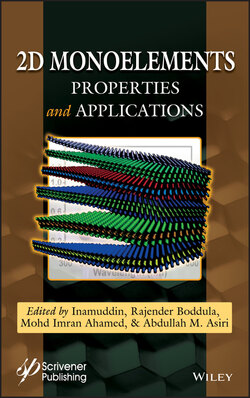Читать книгу 2D Monoelements - Группа авторов - Страница 52
2.4.3 Electrocatalysis
ОглавлениеTwo-dimensional materials with atomic-scale thickness have more active sites and defects, as well as larger surface areas, which can achieve much higher catalytic activity than their bulk counterpart. Therefore, these 2D electrocatalysts can be effectively used to catalyze the CO2 reduction reaction (CO2RR), HER, and oxygen evolution reaction (OER) [51–53]. Combining the advantages of metals and non-metals, 2D semi-metals with high carrier concentration and short charge transfer channel exhibit enhanced catalytic activity for low catalytic threshold and efficient charge transfer [54]. Few-layer antimonene is expected to be employed as an active 2D electrocatalyst due to its semi-metallic nature.
Li et al. produced few-layer antimonene nanosheets (SbNSs) by cathodic exfoliation, then applied them into the electrocatalytic process of CO2RR [55]. Compared with bulk Sb, few-layer SbNSs exposed more active edge sites, thus could obtain higher catalytic efficiency. Figure 2.9a shows the linear-sweep voltammetric (LSV) curves of bulk Sb- and SbNSs-modified working electrodes recorded in N2- and CO2-saturated 0.5 M NaHCO3 solutions, it is observed that the SbNSs electrode exhibits a lower onset potential and a significantly enhanced catalytic current density compared to bulk Sb electrode. At the same time, the SbNSs electrode shows a broad peak with the center position at −1.06 V in the CO2-saturated NaHCO3 solutions. The reduction products are composed of H2, CO, and formate. Furthermore, they also prepared few-layer antimonene nanosheet-graphene (SbNS-G) composites, then compared their catalytic activity with SbNSs, concluding that SbNS-G-modified electrode possessed a higher Imass than SbNSs electrode. As illustrated in Figure 2.9b, the SbNS-G also presented an enhanced selectivity towards product formate at lower overpotentials, where the maximum faradaic efficiency (FE) was 88.5% at an overpotential of 0.87 V (potential of −0.96 V) higher than 84% of SbNSs (potential of −1.06 V). Moreover, the partial current density for formate of SbNS-G at −1.07 V is 1.5 and 16 times larger than that of SbNSs and bulk Sb, respectively (Figure 2.9c). The enhanced catalytic performance of SbNS-G is attributed to the strong electronic interaction between SbNS and graphene.
Figure 2.9 (a) LSV curves of bulk Sb- and SbNSs-modified glassy carbon electrodes in N2- and CO2-saturated 0.5 M NaHCO3 solutions. Scan rate is 50 mVs−1. FE (b) and partial current density (c) for formate of bulk Sb, SbNSs, and SbNS-G. Polarization curves and Tafel plots of antimonene nanosheets for HER (d) and OER (e) in KOH solutions with different concentrations (0.1, 0.2, 0.5, and 1 M). (f) Long-term stability of antimonene nanosheets in 0.5 M KOH. The bias potentials for HER and OER are −1.6 and 1.2 V, respectively. (a–c) Reproduced with permission [55]. Copyright 2017, Wiley-VCH. (d–f) Reproduced with permission [54]. Copyright 2019, American Chemical Society.
After that, Ren et al. adopted LPE-produced few-layer antimonene nanosheet as a metal-free electrocatalyst for full water splitting in alkaline condition [54]. The antimonene nanosheets showed great potentials in catalyzing both HER and OER, because of the semi-metallic nature together with increased active sites and larger surface area compared to bulk Sb. The lowest Tafel slope of antimonene nanosheets was 217.2 mV dec−1 for HER in 0.5 M KOH and 261.3 mV dec−1 for OER in 1 M KOH (Figures 2.9d, e). Additionally, bifunctional antimonene nanosheets presented a long-term stability in KOH solution, benefiting for durable and efficient electrocatalysis of full water splitting (Figure 2.9f).
